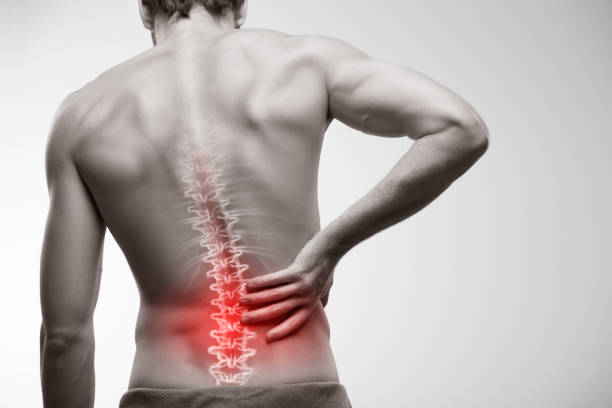Acupuncture for Muscular Pain
Published 13th March 2018

Muscular pain is one of the most frustrating yet commonly experienced problems.
Research shows that each year in England, the NHS spends £4.7 billion on musculoskeletal problems. Back pain in particular is the prime cause of workplace absence, with 30.8 million working days lost in the UK in 2016*. Medication for back pain, such as codeine, tramadol, cortisone injections etc is a multibillion pound industry and recent developments in treatment include pain transmitter blockers being inserted via surgery. It is hardly surprising that I treat back problems on a daily basis in my clinic.
The NHS is stretched to the maximum and there is a range of chemical solutions to the problem, from tablet form to more intrusive, serious medications. But there is no guarantee of short or long term success. Maybe this is why many people look to alternative medicine for help. Until 2017 the NHS included acupuncture in it’s pain back treatment protocols. Unfortunately this is no longer the case, presumably due to the cost implications and the fact that it is easily accessible in the private sector. Here in the UK there are two main approaches with acupuncture. The dry needling techniques offered by physiotherapists and the ancient art of Traditional Chinese Acupuncture. The actual needles used by both approaches are very similar, but the acupuncture points chosen and the reasoning behind the choice is very different. Western Approach: Dry Needling
Dry needling can be very effective at changing the way the body listens and reacts to the pain message being sent by an injured muscle/ tendon. By inserting the needle into the painful nerve bundle at the site of the injury, the pain message can be blocked, thereby allowing the muscle to relax which results in a reduced pain signal being sent to the brain. In effect, it stops the pain – tension cycle. Results can be experienced quickly. Usually the dry needling is used alongside physiotherapy massage and exercises to maximise the benefit. This approach follows the western medical approach of “What is the symptom? – Address the symptom”.
Traditional Chinese Approach: Acupuncture
Traditional Chinese Medicine is a medical system which considers the symptoms of the whole body (not just the injury) and emotional state of the patient when deciding the right prescription of needles to use. Usually a wide range of medical history questions will be asked, some of which can seem bizarre eg. “Do you dream a lot? Do you prefer hot drinks to cold ones? Do you often feel frustrated?” The answers to these questions, along with an observation of your tongue and pulse and a discussion about the injury or pain felt, will guide the TCM practitioner to make a diagnosis. It is a very different approach to the one utilised by a western medical practitioner.
Unique Treatment Principles of TCM:
1) The Ben & The Biao
The TCM approach will look to use acupuncture points which address the “Ben” – The Root or Root Cause and the “Biao” – The Branch or surface symptom** By using a combination of the Ben & Biao, both the immediate injury can be treated as well as addressing the cause of the injury, helping to prevent future problems.
2) Ashi Points<
This term refers to a particularly sore point on a muscle or injury site. Similar to a nerve bundle point which a western practitioner would dry needles. Needling an ashi point encourages blood and qi to the area which activates a healing response by the body. Despite the ashi point being sore to the touch, it often can’t be felt when needled.
3) Emotions
The emotional landscape of a patient is intrinsically linked to their physical health. Many of the TCM acupuncture points have an emotional effect as well as a physical one. Each organ of the body has an emotion attached to it, for example, the Liver is linked with the emotion of frustration & anger and controls the tendons and sinews. This means that for muscular injuries, Liver meridian acupuncture points are often included in a prescription.
4) “Ice is for Dead People”
This is a well known Chinese saying because in TCM, heat is used far more than ice to treat injuries. The heat, which is usually in the form of moxabustion or an infrared heat lamp, encourages the flow and circulation of blood and qi to the injury which works with the body’s natural inflammatory process of healing. Ice in contrast, reduces blood flow and although will limit swelling, will also hinder the healing ability of the body. This can lengthen the healing and recovery time.
5) Cupping Therapy
Cupping therapy is often used by TCM practitioners alongside acupuncture. It is a fantastic method of encouraging blood flow through an injury, thus improving the healing process. Plastic or glass cups are used and placed on the body. Either a flame or a suction implement is then used to create a vacuum within the cup. This then sucks the skin and underlying tissue into the cup. It is extremely effective at moving the pain and tension of a muscle injury.
Of course, prevention is always better than cure. Make sure you eat properly and nourish your body so that it can function properly. Listen to your body’s warning signs, sometimes the ‘push on through’ approach is not good for the long term. Allow yourself time to heal and recover and do not set yourself a deadline of when you should be better. Try to live a happy life. Stress and tension will ultimately hinder your body’s ability to function properly so please add calm, relaxing things into your diary.
If you’d like to know more about how Traditional Chinese Medicine and Acupuncture can help, please get in touch,
Gabby
*arthritis research UK

